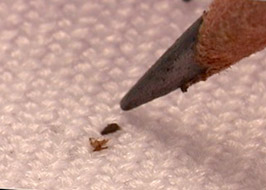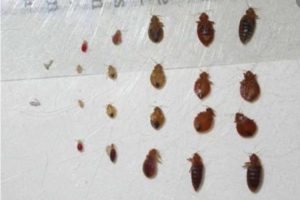

The nymphs feed on blood immediately after hatching and will molt five times before they reach adulthood. The eggs are white ovals that take between 6 to 10 days to hatch. In an unoccupied room it may be sufficient to end a small infestation if the pests do not latch on to the person placing and checking the traps and move with them to a more populated area in the residence.įemales lay eggs that are about one-sixteenth of an inch in length. The homemade traps, that typically include a yeast mixture, are not enough to lure the bugs because they don’t release more carbon dioxide than a human. The allure of carbon dioxide to bed bugs has led to many DIY traps. This is one of the reasons why the bites are often in rows. If the host moves or otherwise disturbs the feeding the bug will stop, move slightly and begin to feed again.

It will feed for approximately 3-12 minutes.
Bed bug pictures actual size skin#
The insect finds a host, positions itself on bare skin and stabs through the skin with its beak. The bed bug finds a host through body heat as they are attracted to warmth as well as to the carbon dioxide found in exhaled air.Ĭarbon dioxide is an indicator of a living creature, so it attracts any parasitic insects looking for a fresh meal. People that have only small numbers of the bugs in their homes may not experience new bites every night.
Bed bug pictures actual size full#
The bugs can bite several times in a night to become full but only feed about once every one or two weeks. People that work a night shift can be bitten during the day when the insects are near. Homes with bed bug infestations can have extremely high histamine levels and this can aggravate allergies and asthma.īed bugs are mostly nocturnal, but their feeding habits can become a matter of convenience. The number of people infected in the United States has increased in the last few years.Ī more common concern is the potential of the insect to sicken people with allergies and respiratory conditions. It is a fatal illness that can affect the cardiovascular, digestive and nervous systems. Serious illness from a bed bug bite is rare, but it can happen. One feature of the bites that stands out is that they tend to appear in straight rows of three or four welts. The bites are red welts that look like mosquito or flea bites. The bites of the bed bug are usually in areas that are easy for them to access while a person is asleep.Įxposed skin like shoulders, arms and legs become the main targets. The insects will hide in mattress seams as well as in folds of fabric on and around the bed. The spots are excrement, shed skins and egg shells as well as the nymphs. The blood stains may come from the bites but are usually the excrement left behind by the insects.Ī musty or moldy smell may be noticeable, but this is usually not detected unless there is a large population of the insects.Ī close look around the seams of the mattress may reveal black and yellow specks and more rusty stains. The first signs many people notice of a problem are the itchy bites on their bodies that often appear overnight and small spots of blood on their bedsheets. The insect cannot fly or jump but does like to hitch rides on passers by. One way to rule out some lookalikes is how bed bugs move. The welts from a bed bug bite do not distinguish the creature either because the bites can look and feel like many other itchy bug bites. Spider and carpet beetles, booklice, cockroach nymphs, and fleas and ticks are the pests most often mistaken as bed bugs. There are many insects that people commonly misidentify as bed bugs. Severe infestations of the insect may even cause them to take up residence in wallpaper, cracks in walls or flooring or inside electrical outlets. Their tendency to take up residence in beds most often is how they got their name but bed bugs can hide in curtains, chairs, and carpets. The bed bug does not have any physical characteristics that make it unique, so it is easy to mistake it for other small insects like beetles and ticks.Īny place in a home can be a hiding spot for a bed bug, but they are usually found in mattresses and other soft furnishings. The adults are reddish-brown, and nymphs are similar in appearance but even smaller and lighter in color. Bed bugs are tiny insects that are the shape of an apple seed but slightly smaller.


 0 kommentar(er)
0 kommentar(er)
